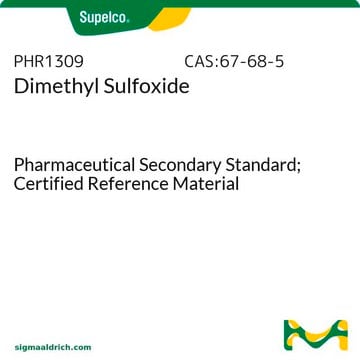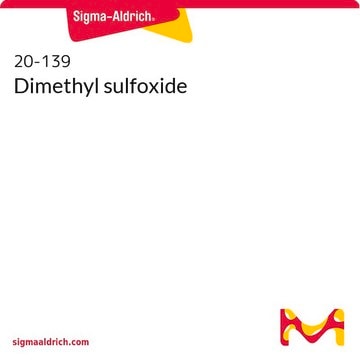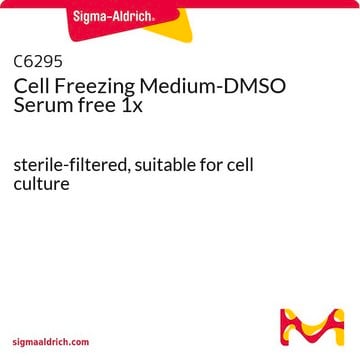Products may be shipped at a different temperature than the recommended long-term storage temperature. If the product quality is sensitive to short-term exposure to conditions other than the recommended long-term storage, it will be shipped on wet or dry-ice. If the product quality is NOT affected by short-term exposure to conditions other than the recommended long-term storage, it will be shipped at ambient temperature. As shipping routes are configured for minimum transit times, shipping at ambient temperature helps control shipping costs for our customers. For more information, please refer to the Storage and Transport Conditions document: https://www.sigmaaldrich.com/deepweb/assets/sigmaaldrich/marketing/global/documents/316/622/storage-transport-conditions-mk.pdf
41639
Dimetilsulfóxido
BioUltra, for molecular biology, ≥99.5% (GC)
Sinónimos:
DMSO
Seleccione un Tamaño
Seleccione un Tamaño
About This Item
Productos recomendados
grado
for molecular biology
Nivel de calidad
densidad de vapor
2.7 (vs air)
presión de vapor
0.42 mmHg ( 20 °C)
Línea del producto
BioUltra
Ensayo
≥99.5% (GC)
Formulario
liquid
temp. de autoignición
573 °F
lim. expl.
42 %, 63 °F
impurezas
Dnases, none detected
RNases, none detected
insoluble matter, passes filter test
phosphatases, none detected
proteases, none detected
≤0.001% free acid (as CH3COOH)
residuo de evap.
≤0.005%
color
colorless
índice de refracción
n20/D 1.479 (lit.)
n20/D 1.479
bp
189 °C (lit.)
mp
16-19 °C (lit.)
solubilidad
H2O: miscible (completely)
densidad
1.10 g/mL (lit.)
trazas de catión
Al: ≤0.5 mg/kg
Ba: ≤0.1 mg/kg
Bi: ≤0.1 mg/kg
Ca: ≤0.5 mg/kg
Cd: ≤0.05 mg/kg
Co: ≤0.02 mg/kg
Cr: ≤0.02 mg/kg
Cu: ≤0.02 mg/kg
Fe: ≤0.5 mg/kg
K: ≤0.5 mg/kg
Li: ≤0.1 mg/kg
Mg: ≤0.1 mg/kg
Mn: ≤0.02 mg/kg
Mo: ≤0.1 mg/kg
Na: ≤1 mg/kg
Ni: ≤0.5 mg/kg
Pb: ≤0.1 mg/kg
Sr: ≤0.1 mg/kg
Zn: ≤0.1 mg/kg
cadena SMILES
CS(C)=O
λ
neat
Absorción UV
λ: 280 nm Amax: 0.22
idoneidad
suitable for molecular biology
InChI
1S/C2H6OS/c1-4(2)3/h1-2H3
Clave InChI
IAZDPXIOMUYVGZ-UHFFFAOYSA-N
¿Está buscando productos similares? Visita Guía de comparación de productos
Descripción general
Aplicación
Precaución
Otras notas
Código de clase de almacenamiento
10 - Combustible liquids
Clase de riesgo para el agua (WGK)
WGK 1
Punto de inflamabilidad (°F)
188.6 °F - closed cup
Punto de inflamabilidad (°C)
87 °C - closed cup
Equipo de protección personal
Eyeshields, Gloves, type ABEK (EN14387) respirator filter
Elija entre una de las versiones más recientes:
¿Ya tiene este producto?
Encuentre la documentación para los productos que ha comprado recientemente en la Biblioteca de documentos.
Los clientes también vieron
-
How is shipping temperature determined? And how is it related to the product storage temperature?
1 answer-
Helpful?
-
-
How can I determine the shelf life / expiration / retest date of this product?
1 answer-
If this product has an expiration or retest date, it will be shown on the Certificate of Analysis (COA, CofA). If there is no retest or expiration date listed on the product's COA, we do not have suitable stability data to determine a shelf life. For these products, the only date on the COA will be the release date; a retest, expiration, or use-by-date will not be displayed.
For all products, we recommend handling per defined conditions as printed in our product literature and website product descriptions. We recommend that products should be routinely inspected by customers to ensure they perform as expected.
For products without retest or expiration dates, our standard warranty of 1 year from the date of shipment is applicable.
For more information, please refer to the Product Dating Information document: https://www.sigmaaldrich.com/deepweb/assets/sigmaaldrich/marketing/global/documents/449/386/product-dating-information-mk.pdfHelpful?
-
-
What is the molarity of DMSO?
1 answer-
DMSO will have a molarity of 14.1M, based on a density of 1.1 g/mL and a molecular weight of 78.13 g/mol.
Helpful?
-
-
Is Dimethyl sulfoxide a sterile product?
1 answer-
No, this product is not considered sterile. Product Nos. D2560 and D2438 are sterile-filtered.
Helpful?
-
-
What type of filter is used to sterile-filter Dimethyl sulfoxide (DMSO)?
1 answer-
DMSO can be sterile-filtered through a 0.2 micron PTFE filter. The sterility testing is per the current US Pharmacopoeia method.
Helpful?
-
-
What is Sure/Seal™ packaging?
1 answer-
The Aldrich Sure/Seal™ packaging system is useful in the handling and storage of air-sensitive reagents.
Helpful?
-
-
Where does DMSO come from?
1 answer-
DMSO is known to have been isolated from tree bark in the past. It is now a commericially synthesized solvent.
Helpful?
-
-
Does DMSO have any synthetic utility?
1 answer-
DMSO has been used to oxidize thiols and disulfides to sulfonic acids, hydrolysis of epoxides, thioalkylation of phenols, and oxidation of primary alcohols and halides, and esters of primary alcohols to aldehydes.
Helpful?
-
-
Dimethyl sulfoxide (DMSO) should be a liquid. Why did it arrive as a solid?
1 answer-
DMSO supercools easily, and re-melts slowly at room temperature. The melting point is 16-19 °C. The solidified product can be re-liquefied by warming to room temperature without detriment to the product.
Helpful?
-
-
What is the Department of Transportation shipping information for this product?
1 answer-
Transportation information can be found in Section 14 of the product's (M)SDS.To access the shipping information for this material, use the link on the product detail page for the product.
Helpful?
-
Active Filters
Nuestro equipo de científicos tiene experiencia en todas las áreas de investigación: Ciencias de la vida, Ciencia de los materiales, Síntesis química, Cromatografía, Analítica y muchas otras.
Póngase en contacto con el Servicio técnico




